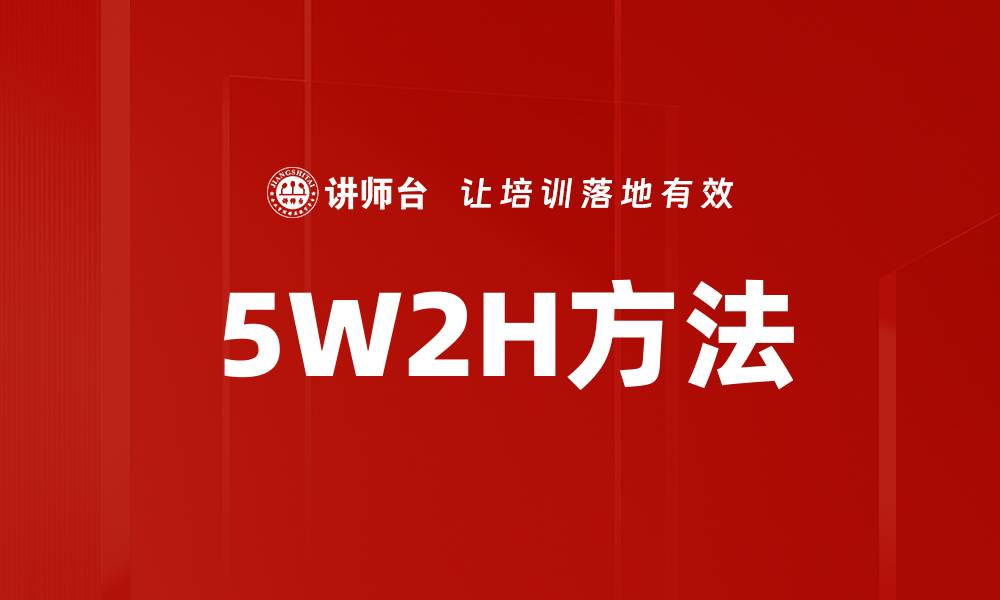
5W2H方法是一种广泛应用于项目管理、问题解决和决策制定的工具,旨在帮助团队明确目标、制定计划并有效执行。它包含七个关键要素,分别是:What(是什么)、Why(为什么)、When(何时)、Where(在哪里)、Who(谁)、How(如何)和How much(多少费用)。通过对这七个要素的系统分析,团队能够更全面地理解任务的背景、目的和执行流程,从而提高执行力和责任心。
5W2H方法起源于20世纪的日本,最初用于制造业的质量管理与控制。随着时间的推移,这一方法逐渐被引入到其他领域,包括项目管理、战略规划、市场营销及人力资源管理等。它的成功在于能够有效地将复杂问题简化为具体的、可操作的步骤,使团队在面对挑战时能够快速做出反应并实施解决方案。
This component defines the specific task or project at hand. It clarifies what needs to be accomplished and outlines the expected outcomes. A well-defined 'What' helps in reducing ambiguity and aligning team members on the objective.
The 'Why' addresses the rationale behind undertaking the task or project. Understanding the purpose not only motivates team members but also provides context, which is crucial for prioritizing the task among other responsibilities. It can also help identify potential challenges that may arise if the project is not executed.
This element focuses on the timeline for the project. It establishes deadlines and milestones, ensuring that team members are aware of the time constraints. A clear timeline aids in tracking progress and maintaining momentum throughout the execution phase.
The 'Where' specifies the location or environment where the task will be performed. This could refer to a physical space, like an office or factory, or a virtual environment, such as a digital workspace. Identifying the 'Where' is essential for logistical planning and resource allocation.
This component outlines the individuals or teams responsible for executing the task. Clearly defined roles and responsibilities foster accountability and ensure that all necessary skills are available for successful completion. This also facilitates communication and collaboration among team members.
The 'How' describes the methods and processes that will be used to complete the task. This includes the tools, techniques, and strategies that will be employed. A well-articulated 'How' ensures that everyone is on the same page regarding the approach to be taken, reducing the likelihood of errors or miscommunication.
This final element addresses the budget or resources required for the project. Understanding the financial implications helps in planning and securing necessary funds, as well as in managing costs during the execution phase. This aspect is critical for ensuring that the project remains financially viable.
在企业管理中,5W2H方法被广泛应用于多种场景,包括项目管理、战略规划、市场营销及人力资源管理等。通过清晰地定义任务的各个要素,企业能够有效提高团队的执行力和责任心。
项目管理是5W2H方法最常见的应用场景之一。在项目启动阶段,项目经理可以利用5W2H方法明确项目目标、团队成员、执行时间表及预算,从而为项目的顺利推进奠定基础。在项目执行过程中,团队可以定期回顾这些要素,确保项目按计划进行,并在必要时进行调整。
在市场营销中,5W2H方法可以帮助企业制定清晰的营销策略。例如,在推出新产品时,团队可以通过5W2H分析确定目标市场、营销渠道、推广时间及预算等。这种系统化的分析方法能够提高营销活动的有效性和针对性。
在人力资源管理中,5W2H方法可以用于招聘、培训及绩效管理等流程。通过明确招聘需求、培训目标及评估标准,HR团队能够更有效地管理人力资源,提高员工的积极性和责任感。
5W2H方法不仅帮助团队明确任务目标,还能显著提升执行力。通过细化任务的每个要素,团队成员能够更清晰地理解自己的职责和预期成果,从而增强责任心。以下将探讨5W2H方法如何在实际案例中提升团队执行力。
某企业在新产品开发过程中,面临着目标不明确、团队协作不畅等问题。通过引入5W2H方法,团队首先明确了项目的目标(What),厘清了开展项目的原因(Why),制定了详细的时间计划(When),选择了适合的工作地点(Where),明确了参与人员及其职责(Who),设定了执行策略(How),并确定了预算(How much)。通过这一系列的分析和规划,团队的执行力显著提高,最终顺利完成了项目。
责任心是团队执行力的重要组成部分。5W2H方法通过明确任务目标和个人职责,帮助团队成员意识到自己在项目中的重要性。以下将探讨5W2H方法如何促进员工责任心的提升。
通过5W2H分析,团队成员能够清晰地了解自己的责任范围和义务。这种明确性有助于提高员工的责任意识,促使他们更加主动地承担任务,并在工作中展现出积极的态度。
在5W2H方法的指导下,团队成员能够更有效地协作。通过明确团队目标和个人职责,各成员能够相互支持、配合,从而形成良好的团队氛围,增强集体责任感。
当团队成员明确自己的任务和预期成果后,他们的工作积极性往往会随之提高。5W2H方法通过激励员工主动参与和贡献,增强了他们对工作的投入感和责任感。
5W2H方法作为一种有效的管理工具,在企业管理、项目实施及团队建设中具有重要的应用价值。通过明确任务的各个要素,团队不仅能够提高执行力,还能增强责任心。在未来的管理实践中,5W2H方法将继续发挥其重要作用,帮助企业实现更高效的目标管理和团队协作。
以上内容为5W2H方法的详细介绍及应用分析,希望能够为读者提供有价值的参考与启示。